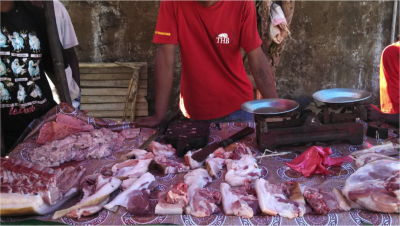“What kind of meat have you eaten in the last three days?”
“Have you ever eaten lemur meat?”
“What kind of fadys (taboos) do you have against meat?”
Imagine asking these questions almost 2,000 times to complete strangers across 21 cities and villages across Madagascar; if you’d been asked, what kind of response would you have given? If you happened to be one of the Malagasy interviewees that my research team spoke to in 2013, you might have said that you’d eaten chicken once in the last three days, eaten lemur a couple of times in your life, and that you had a familial taboo against eating wild pigs. The data collected in this interview would have been meticulously jotted down on paper interview sheets, later translated and transcribed into massive electronic datasets, and analyzed over the course of 2.5 years resulting in two landmark papers just published on the urban Malagasy bushmeat trade.
These papers, published in PLOS ONE and Environmental Conservation, tell us that in Madagascar, wild animals are moved hundreds of kilometers from rural to urban areas as part of the bushmeat trade. In these urban areas, the animals – which are often classified by the IUCN Red List as Threatened or Endangered – are sold at well-known market stalls, restaurants, and even high-end super-markets to urban consumers. Surprisingly, we found that urban consumers in Madagascar not only ate twice as much bushmeat as their rural counterparts, but are willing to pay higher prices for it as well.
The animals eaten and traded as bushmeat in Madagascar include Endangered lemurs, fossa, and fruit bats. The bushmeat trade is active in rural and urban areas and crosses religious, ethnic, and geographic boundaries.
How did my colleagues and I collect these data? It wasn’t easy and it involved spending three months in Madagascar surveying almost 2,000 households, meat-sellers, and inter-city transporters in 21 cities and villages across the country’s northern half about the bushmeat trade. Together with my co-authors, we have now published the results in two new articles: “Capture, movement, trade, and consumption of mammals in Madagascar,” in the open access journal PLOS ONE, and “The consumption of wild meat in Madagascar: drivers, popularity and food security,” in the interdisciplinary environmental science journal, Environmental Conservation.
The the largest study of the urban bushmeat trade in Madagascar
Frankly, these studies change and expand how we – and how I – view the bushmeat trade in Madagascar. I came into this study assuming that we wouldn’t find much of an urban demand for bushmeat, but I couldn’t have been more wrong. In fact, we found that in urban areas of Madagascar, the most important driver of bushmeat consumption was an interviewee’s preference for bushmeat. I had expected that food security would be a big predictor (which is what has been found in rural areas of the country, notably by Christopher Golden at MAHERY), but this was not the case.
We were also able to help characterize the structure and flow of the bushmeat trade, and how it differed between different types of animals. Most strikingly, we found that bushmeat consumed in urban areas has often been moved hundreds of kilometers and is often sold through well-known market stalls and restaurants. These market stalls and restaurants are prime opportunities for targeted outreach and conservation efforts, and they have not been acknowledged or yet incorporated into existing conservation programs.
How does this affect lemurs?
Our studies provide mixed evidence for the impact of the illegal bushmeat trade on lemurs. It was disheartening to find that so many individuals had consumed lemurs in their lifetime, and had done so multiple times. Also, because most records of hunting and bushmeat consumption involved small animals, we hypothesize that large animals like lemurs have been hunted to such rarity that they are no longer a major species involved in the bushmeat trade, at least compared to other mammals.
Promisingly, we found no evidence of a luxury trade in lemur meat, which had widely been speculated about following the 2009 change in government in Madagascar. Although respondents very openly discussed their sources of lemur meat with us in great detail, not one individual had purchased lemur meat from a restaurant in the past few years. Rather, most individuals hunted lemurs opportunistically and we found no evidence of an organized trade in lemur meat. Second, the thousands of people that we interviewed had last eaten lemur more than a decade ago, on average, which is promising. Finally, almost none of the individuals that we spoke to had lost their traditional taboos regarding bushmeat consumption and 14 times more individuals had decreased their consumption of bushmeat in their lifetimes compared to the number of people who had increased consumption.
What comes next?
Although bushmeat hunting and trade is often illegal, enforcement of the law in Madagascar is weak. We found evidence that tens of thousands of animals are traded in Madagascar per year and there is virtually no enforcement to combat this trade. In addition, there hasn’t been much attention paid to the urban areas of Madagascar and their role in the bushmeat trade although our studies clearly show a need to focus on these areas. This is especially true because some animals, like Endangered fruit bats, are more likely to be purchased by the general public from markets and restaurants – in both rural and urban areas – than hunted.
To seriously and sustainably combat the bushmeat trade in Madagascar, we need to:
- Work with communities in rural areas to provide them with alternatives to bushmeat (this work is already being pioneered by MAHERY);
- Develop and implement outreach programs for urban consumers to address their preference for bushmeat and their willingness to purchase bushmeat even when it costs more than other types of meat;
- Increase enforcement of market stalls, high-end supermarkets, and restaurants that are selling bushmeat to ensure that they abide by the laws that govern when and what type of bushmeat they can sell;
- Encourage a larger discussion about the drivers of bushmeat consumption, which are complicated, convoluted, and not as straight-forward as previously hypothesized.
I am confident that we can work together to help address this threat to Madagascar’s lemurs and endangered animals. But we need to act swiftly, with clarity, and together in partnership with Madagascar’s communities and stakeholders. The illegal bushmeat trade is not something that one person or one entity can combat. This will require the collaboration of dozens of organizations over the next few years. I am optimistic that the conservation community will rise to the challenge. As evidenced time and again, conservation only works when we work together.
More information:
In addition to Kim Reuter, co-authors on these papers include Temple University alumni Haley Randell, Abigail Wills of the Mpingo Conservation & Development Initiative in Tanzania, Temple University Assistant Professor of Biology Brent Sewall, and University of Antsiranana alumni Totozafy Eric Janvier and Tertius Rodriguez Belalahy. The research was funded by the National Science Foundation, Explorers Club and a Temple Faculty Senate grant. Manuscripts resulting from this work can be read in the PLOS ONE and Environmental Conservation journals. A press release can be found at this link.
Take Action
- Participate in Kim’s Pet Lemur Survey project or learn more about Kim on her website (www.kimreuter.com)
- Read more about this research project on the Smithsonian Magazine website!
- Follow the Lemur Conservation Network on facebook and twitter, so that you can get updates about organizations working across Madagascar to save lemurs and combat bushmeat hunting.








